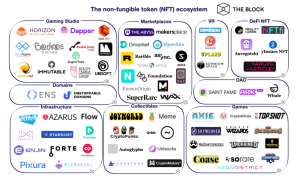Non-fungible tokens

Non-fungible tokens, more commonly known as NFTs, are cryptographic tokens on a blockchain with unique identification codes and metadata. They let people tokenize things like art collectibles, and real estate. They can only have one official owner at a time and because they are stored on the blockchain their record of ownership can’t be altered.[2] Non-fungible is an economic term that is used to describe things that are not interchangeable for other items because they have unique properties. Fungible items however, can be exchanged for one another because they do not have unique properties.[2] Unlike cryptocurrencies, which are fungible tokens, they can’t be traded or exchanged at equal value because each is unique. [3] It is impossible for one non-fungible token to be equal to another because each token is unique due to their metadata. NFTs can be used to represent real world items like artwork, real estate, and clothing.[3]
Because NFTs exist on blockchains, they can be used to connect artists directly to their audiences, removing intermediaries and simplifying transactions.
Contents
Technology
Blockchains

IPFS
References
- ↑ M. (2020, October 29). NFT Ecosystem Overview. The Nifty Crypto Nomad. https://niftycryptonomad.com/nft-ecosystem-overview/
- ↑ 2.0 2.1 Ethereum. (2022). Non-fungible tokens (NFT). Ethereum.Org. https://ethereum.org/en/nft/
- ↑ 3.0 3.1 Non-Fungible Token (NFT). (2021, December 14). Investopedia. https://www.investopedia.com/non-fungible-tokens-nft-5115211
- ↑ Team, P. (2022, January 25). Top Ten Blockchains Used in NFT Development. PixelPlex. https://pixelplex.io/blog/top-ten-blockchains-for-nft-development/